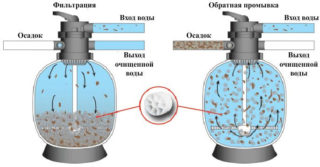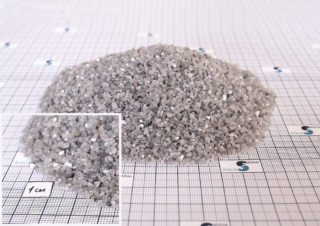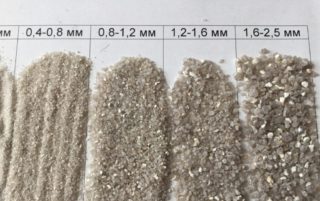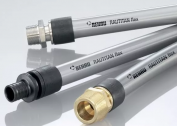High-quality water treatment is the key to good health and well-being. At the same time, various methods can be used for water treatment. As a mechanical, sand filters are used to purify water. They rid the liquid of various suspensions and harmful impurities. The basis of the filter is quartz sand. It is the most affordable natural mineral on the planet.
Scope of quartz sand for water purification
Use quartz sand to filter water in such areas:
- utilities preparing liquid for supply to subscribers (Vodokanal, etc.);
- water purification in aquariums;
- fluid filtration in pools;
- local sewage treatment plants;
- private ownership, autonomous well or borehole water supply.
Quartz-based filters are widely applicable in industrial fields - mechanical engineering, petrochemical processes, energy.
Properties of quartz for water purification
Sand has a number of positive properties:
- detrimental effect on parasites;
- reduces the concentration of radionuclides in the treated medium;
- completely removes chlorine, iron, manganese, aluminum from water;
- collects heavy metal ions by adsorption;
- inhibits bacteria and viruses.
Sand made of quartz has good porosity. From this, the dirt present in the liquid settles as much as possible in the quartz mass. In addition, the bulk material is resistant to any mechanical stress.
Classification and standardization of quartz sand
Quartz natural sand is mined in places of mineral deposits. The resulting material is washed thoroughly and then enriched electrochemically. Artificial quartz is obtained by grinding stone blocks. It is called crushed. Finished raw materials are sieved to sort the material by the size of the fraction of grains of sand.
At the place of extraction of quartz bulk material, the following are distinguished:
- mountain;
- river;
- dune;
- cellar.
Quartz filler for filter systems and systems must comply with GOST R51641-2000. The latter regulates the standards and requirements for mineral treatment additives. Established standards are fully consistent rounded and crushed sand. The first is the most durable, pre-calcined in furnaces at high temperatures. Crushed - as porous as possible, having a large number of microcracks.
Criterias of choice
When choosing sand filters for water treatment with quartz, you should pay attention to such parameters:
- The size of the granules (fractional). It is recommended to take material with particles up to 0.8 mm. It is important to familiarize yourself with the technical characteristics of the filter itself and take the sand that is recommended for a particular model. It’s okay if the fraction is a little less or more. But you need to be prepared for the fact that too small particles will leak out of the filter with water, and very large ones will not clean it well.
- The presence and amount of impurities. Good quartz complies with GOST and does not emit harmful substances into a liquid. Such data are indicated on the packaging for the material.
- Color and density. As a rule, high-quality sand has a milky white hue. Its bulk density is uniform.
Purchased quartz is laid in special polymer or metal filters.
Before the first use of the mineral additive as a cleaning agent, it should be washed out from accumulated dust.
Water treatment mechanism
 Three types of quartz filters are used for water treatment:
Three types of quartz filters are used for water treatment:
- sand;
- diatomaceous earths;
- cartridge.
The principle of processing the liquid is that water using a special pump several times (5-6) per day is driven through the sand layers. In this case, first, all impurities settle on the surface of the granular layer, and then suspended particles remain in its bulk.
To increase the filter capacity, it is advisable to use special metering pumps. The quality of water treatment directly depends on the size of the grains of sand. The smaller they are, the better the water treatment goes.
It is necessary to regularly change quartz filters in order to prevent their re-contamination.
Disadvantages and advantages of quartz sand water treatment
The main advantages of using quartz as a treatment system are as follows:
- An excellent indicator of the uniformity of grains of sand. Reaches 98%.
- Explicit fraction size equal to 97% of the total.
- High porosity of crushed material, which increases its filtration ability.
- Large surface area, due to which a high speed of passage of the volume of water through the sand filler is achieved.
- Excellent dirt holding capacity of quartz bulk material. A large number of suspensions present in the liquid settle in its thickness.
- The ability to use crushed material as a support layer for multi-stage filters.
- A large selection of types of quartz sand in terms of fraction size and even color.
The real disadvantages of quartz include:
- The presence of dust or a small amount of clay in the bulk material, which must first be removed by washing. Only then can a layer of sand be used as a filter. Water that will be pre-washed with bulk material should not be discharged into the sewer. It should be collected in a separate tank and defend. The settled particles of dust are disposed of as solid waste after the upper settled water is drained.
- Freezing of loose quartz under the condition of natural humidity. Also, sand can freeze if the filter stays in the outdoor pool for the winter.
- The need for frequent replacement of the filtering quartz layer. It needs to be updated as soon as the water has a characteristic stale smell and possible impurities.
- The high cost of bulk material.
People who once tried quartz as a home water filter rated its effectiveness. If there is sand, there is no need to install complex filter systems.




